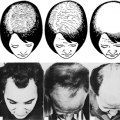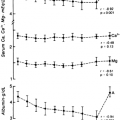MECHANISMS OF HYPOCALCEMIA
Calcium is present in serum in three forms: bound to serum protein (40–45%), complexed to inorganic anions (5–10%), and ionized (˜45–50%).1 Although total serum calcium is most commonly measured, the ionized fraction is most important physiologically.
HYPOALBUMINEMIA
Albumin is the major calcium-binding serum protein, and hypoalbuminemia, rather than a decrease in the concentration of ionized calcium, accounts for most cases of low total serum calcium in hospitalized patients. Because reliable direct measurement of ionized serum calcium is not always readily available, a number of algorithms based on albumin or total protein concentrations2,3 have been proposed for the “correction” of total serum calcium. None of these correction factors should be regarded as absolutely accurate, but they are useful as general indicators of the concentration of ionized calcium in serum. One widely used algorithm estimates that total serum calcium declines by ˜0.8 mg/dL for each 1-g/dL decrease in albumin concentration, without a change in ionized calcium.
IONIZED AND BOUND FRACTIONS
Sudden changes in the distribution of calcium between ionized and bound fractions may cause symptoms of hypocalcemia, even in patients who have normal hormonal mechanisms for the regulation of the ionized calcium concentration. Increases in the extracellular fluid concentration of anions such as phosphate, citrate, bicarbonate, or edetic acid increase the proportion of bound calcium and decrease ionized calcium until intact regulatory mechanisms normalize ionized calcium. Extracellular fluid pH also affects the distribution of calcium between ionized and bound fractions. Acidosis increases the ionized calcium, whereas alkalosis decreases it.1
Stay updated, free articles. Join our Telegram channel

Full access? Get Clinical Tree





